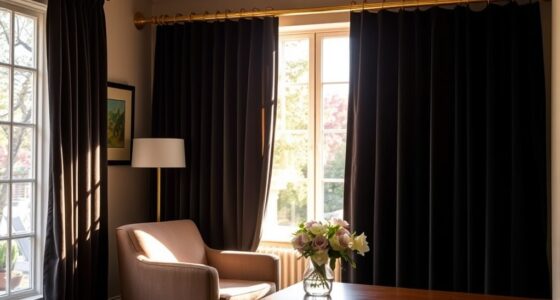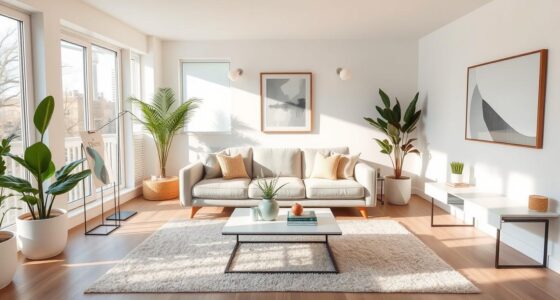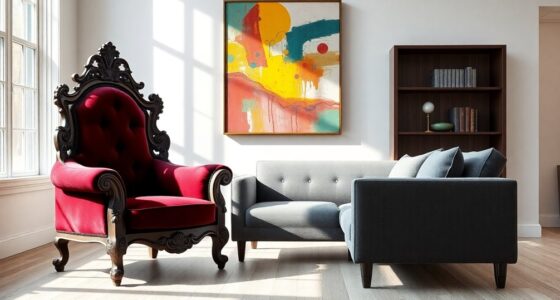Mid-Century Modern and Danish Modern showcase distinct design philosophies. Mid-Century Modern, emerging post-World War II, features bold colors and geometric shapes, often using innovative materials like plastics and metals. It's all about industrial simplicity and functionality. In contrast, Danish Modern emphasizes craftsmanship and natural beauty, favoring light woods and muted tones for a minimalist aesthetic. Its designs prioritize comfort and organic forms. While both styles promote simplicity, their material choices and visual aesthetics differ considerably. If you want to explore more about these engaging design movements, you'll discover even greater insights into their unique qualities.
Key Takeaways
- Mid-Century Modern emerged post-WWII with bold colors and geometric patterns, while Danish Modern originated in the 1930s, emphasizing minimalist aesthetics and craftsmanship.
- Mid-Century Modern features a mix of materials like plastics and metals, whereas Danish Modern prioritizes natural woods and leather for a more organic feel.
- The visual style of Mid-Century Modern is vibrant and striking, contrasting with the calm, neutral tones and textures of Danish Modern design.
- Both styles focus on simplicity and functionality, but Mid-Century Modern leans towards industrial design, while Danish Modern celebrates traditional craftsmanship.
- Market interest in both styles remains strong, with Mid-Century pieces being bold and eye-catching, and Danish Modern furniture offering timeless elegance and investment potential.
Overview of Mid-Century Modern

Mid-Century Modern design, which emerged in the early to mid-20th century, showcases a unique blend of functionality and style. This movement emphasizes open interiors and clean lines, creating spaces that feel both inviting and sophisticated.
Influenced by the Bauhaus movement, Mid-Century furniture often features innovative materials, combining natural woods like walnut with plastics and metals. You'll notice vibrant color palettes and striking geometric shapes, making each piece visually engaging.
The focus on simplicity and comfort guarantees that these designs remain timeless, resonating with contemporary tastes. Whether you're looking to furnish a new home or refresh your space, incorporating Mid-Century furniture can elevate your interior design while celebrating an era of creativity and innovation.
Overview of Danish Modern

When you explore Danish Modern design, you'll notice its emphasis on clean lines and a minimalist aesthetic that highlights natural beauty.
This style prioritizes craftsmanship, using materials like light woods and leather to create functional yet striking pieces.
You'll appreciate how these elements work together to form a harmonious relationship between form and function.
Design Principles and Aesthetics
Danish Modern design stands out for its emphasis on clean lines and a minimalist aesthetic, offering a sculptural and organic feel that sets it apart from other styles.
This design style prioritizes superb craftsmanship, focusing on the beauty of natural materials—especially light-colored wood.
Unlike Mid-Century Modern, which often embraces new technologies, Danish Modern relies on traditional methods, enhancing its unique character.
You'll notice that the originality and innovative forms found in Danish Modern furniture reflect a rich cultural heritage, distinguishing it from the geometric simplicity of Mid-Century Modern designs.
Ultimately, Danish Modern emphasizes creating functional yet aesthetically pleasing pieces, enhancing both beauty and usability in your living spaces—making it a timeless choice among design styles.
Material and Craftsmanship Focus
Craftsmanship is at the heart of Danish Modern design, where natural materials take center stage. This modern design style emphasizes sustainably sourced wood, like beech and oak, which brings warmth and beauty to each piece.
You'll often find leather upholstery enhancing comfort and durability, all while keeping a refined look. The meticulous attention to detail in Danish Modern craftsmanship guarantees every item isn't only functional but also visually appealing.
What truly sets this style apart are the innovative forms and unique silhouettes that showcase the designer's vision. By focusing on originality and sculptural elements, Danish Modern creates an inviting aesthetic that resonates with those who appreciate quality and thoughtful design. Additionally, the use of natural materials in Danish Modern aligns with the sustainable practices found in contemporary decor trends.
Key Characteristics Comparison
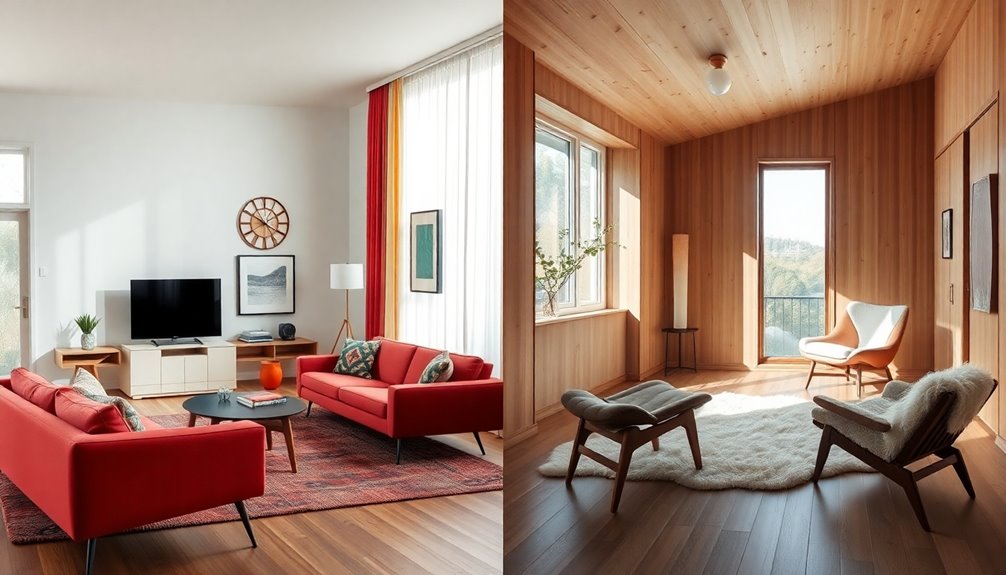
The comparison between Mid-Century Modern and Danish Modern reveals distinct design philosophies that cater to different aesthetic preferences.
While both styles prioritize simplicity and comfort, they express it in unique ways:
- Mid-Century Modern designs boast bold colors and geometric patterns, often featuring industrial aesthetics and varied materials.
- Danish Modern, rooted in Scandinavian design, emphasizes clean lines and organic forms, focusing heavily on natural woods and subtle hues.
- Mid-Century Modern furniture allows for decorative elements, while Danish Modern leans towards a minimalist approach, showcasing texture and craftsmanship.
Understanding these key characteristics helps you appreciate the beauty and functionality that each style offers in the domain of modern furniture.
Material Differences

While both Mid-Century Modern and Danish Modern styles showcase remarkable design, their material choices substantially set them apart.
Mid-Century Modern embraces a mix of materials like plastics, metals, and various woods, reflecting a fascination with new technologies and mass production.
In contrast, Danish Modern emphasizes natural materials, mainly using light woods such as oak and teak, which create a warm, inviting atmosphere.
Leather often enhances Danish Modern upholstery, adding a touch of luxury while maintaining a minimalist aesthetic.
Additionally, while Mid-Century Modern features bold colors and patterns, Danish Modern focuses on the natural beauty of wood grains and textures.
This preference for craftsmanship in Danish Modern highlights the inherent qualities of traditional materials, setting it apart from its Mid-Century counterpart.
Design Philosophy Insights

When you look at Mid-Century Modern and Danish Modern, you'll notice a stark contrast in aesthetics.
While Mid-Century leans toward industrial simplicity, Danish Modern embraces an organic, sculptural feel.
This difference reflects not just design preferences, but also deeper cultural values and craftsmanship philosophies that shape each style.
Industrial vs. Organic Aesthetics
In exploring the contrast between industrial and organic aesthetics, you'll notice how each design philosophy embodies distinct values and visual languages.
Mid-Century Modern leans heavily on industrial principles, showcasing geometric simplicity and innovative materials. In contrast, Danish Modern embraces an organic aesthetic that celebrates sculptural forms and natural materials, especially wood.
Consider these key differences:
- Color Schemes: Industrial designs often feature bold, vibrant colors, while organic designs favor muted tones.
- Production: Mid-Century Modern tends to mass-produce pieces for accessibility, whereas Danish Modern focuses on unique craftsmanship.
- Atmosphere: Industrial aesthetics create sleek sophistication, while organic forms offer warmth and inviting comfort.
Understanding these distinctions helps you appreciate the essence of each design approach.
Craftsmanship and Functionality
The contrast between Mid-Century Modern and Danish Modern design philosophies reveals significant differences in craftsmanship and functionality.
While Mid-Century Modern emphasizes industrial aesthetics and mass production, focusing on functional simplicity, Danish Modern shines with superb craftsmanship and a commitment to traditional techniques.
You'll notice how Danish Modern uses natural materials, especially wood, to create pieces that exude warmth and character, contrasting with the geometric shapes of Mid-Century designs.
Both styles prioritize functionality, but Danish Modern goes a step further by highlighting the tactile qualities of materials.
This results in creations that aren't only practical but also visually appealing, showcasing the skill of the artisan and a deep respect for quality and sustainability.
Cultural Design Interpretations
While both Mid-Century Modern and Danish Modern reflect unique cultural narratives, they diverge markedly in their design philosophies.
Mid-Century Modern embodies an industrial aesthetic, prioritizing mass production and innovative materials—an American response to post-war consumer culture. In contrast, Danish Modern emphasizes craftsmanship, organic forms, and natural materials, focusing on timeless beauty.
Here are three key differences in their cultural design interpretations:
- Material Use: Mid-Century Modern embraces a variety of innovative materials, whereas Danish Modern favors natural woods.
- Aesthetic Approach: Mid-Century Modern features geometric simplicity, while Danish Modern leans towards sculptural, inviting designs.
- Cultural Influence: Mid-Century Modern promotes affordability and functionality, contrasting with Danish Modern's dedication to craftsmanship and elegance.
Market Trends and Availability
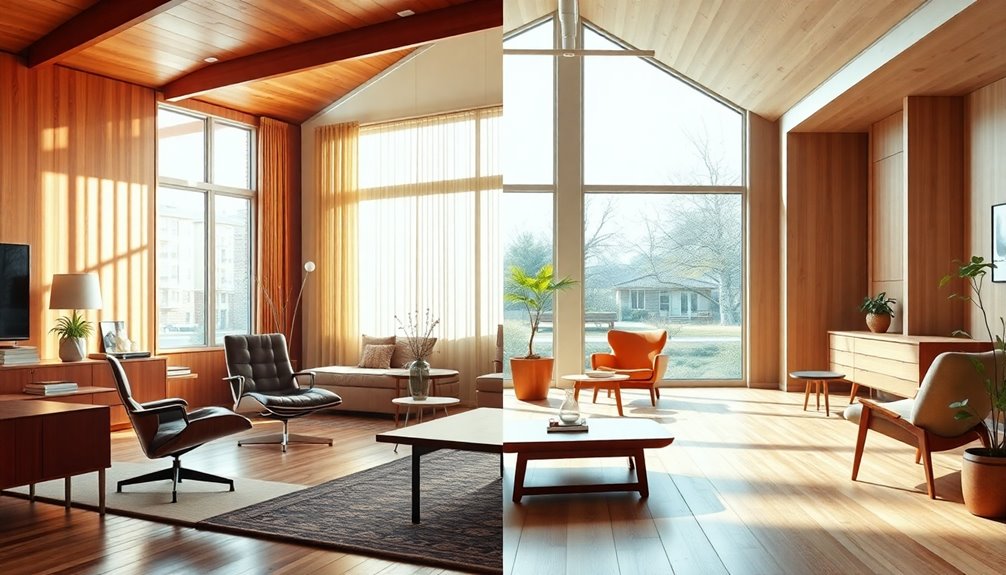
As interest in both Mid-Century Modern and Danish Modern furniture continues to grow, you'll find an impressive selection at the International Design Center, which caters to diverse tastes.
Trendy Danish Modern pieces remain popular across eras, showcasing superb craftsmanship and innovative forms that appeal to discerning consumers.
If you're looking for Mid-Century Modern designs, you can easily locate specialized dealers through the center, making access to these iconic pieces simple.
Pricing information for both styles is available upon request, allowing you to gauge affordability before making a decision.
With an increasing market demand for Modern style furniture, investing in these timeless designs can enhance your space while reflecting your personal taste.
Historical Context of Each Style
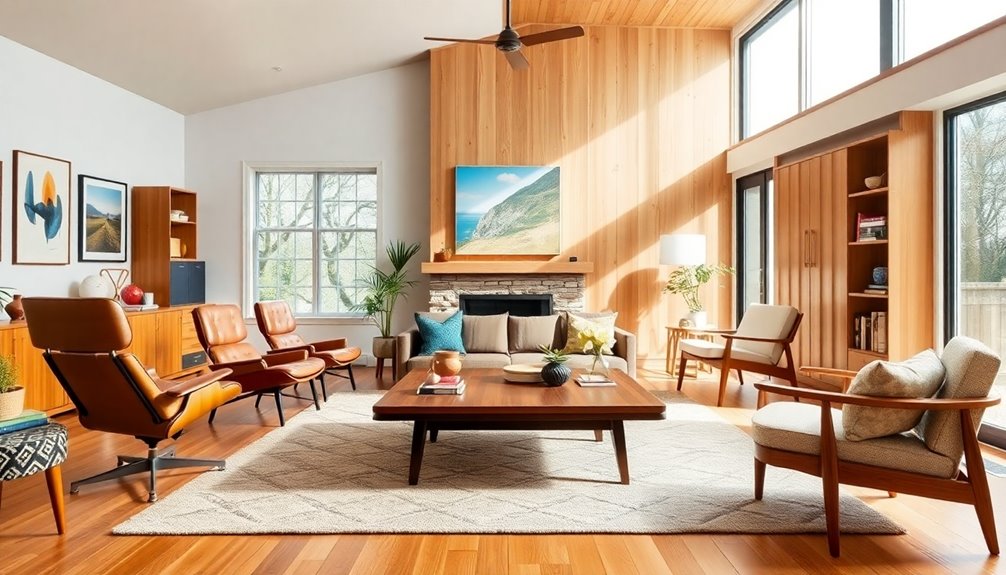
Emerging from distinct cultural backgrounds, Mid-Century Modern and Danish Modern styles reflect the values and societal shifts of their times.
The historical context of these styles showcases their unique influences on modern furniture design:
- Mid-Century Modern evolved in the U.S. post-World War II, driven by optimism and innovative design.
- Danish Modern began in the 1930s, focusing on craftsmanship and natural materials, gaining traction in the 1950s.
- While Mid-Century Modern highlights industrial aesthetics, Danish Modern emphasizes simplicity and organic forms.
Both movements capture the spirit of their eras, with Mid-Century Modern representing an American interpretation of modernism and Danish Modern embracing Scandinavian ideals.
Their legacies continue to shape contemporary design, blending functionality with artistry.
Practical Design Tips
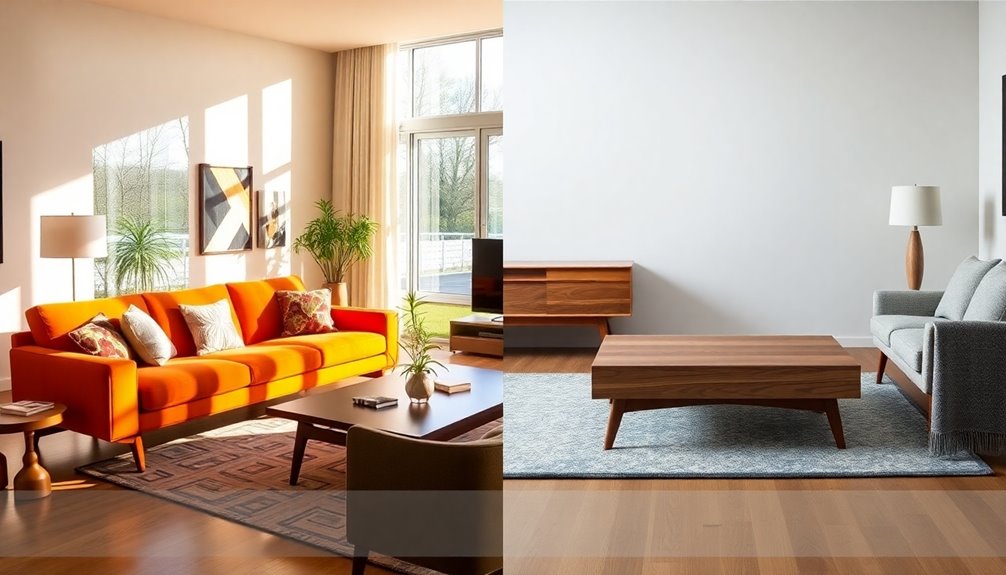
To achieve a balanced interior design, mix bold Mid-Century Modern furniture pieces with the understated elegance of Danish Modern. Look for geometric shapes and pops of color in your Mid-Century items, like a striking Coffee Table, while opting for light wood and natural materials in your Danish pieces.
This design approach creates visual interest and a cohesive look. Don't forget to incorporate multipurpose furniture to maintain functionality.
Finally, use warm textiles, like wool or faux fur, to add comfort and contrast with the clean lines characteristic of mid-century design. You might as well create a welcoming atmosphere! Additionally, consider incorporating natural materials such as wood and stone to enhance the overall aesthetic and connection to nature.
Visual Aesthetics and Preferences

While both Mid-Century Modern and Danish Modern styles share a commitment to simplicity and functionality, their visual aesthetics and preferences create distinct atmospheres.
- Color Palette: Mid-Century Modern boasts bold colors and striking geometric patterns, while Danish Modern favors neutral tones that promote calmness.
- Material Use: Mid-Century often employs various materials, emphasizing new technologies, whereas Danish Modern prioritizes natural woods and textures.
- Form and Shape: Mid-Century furniture features vibrant, intricate shapes, whereas Danish Modern showcases sculptural, organic forms that highlight craftsmanship.
Ultimately, if you prefer a cozy, timeless vibe, Danish Modern might be your go-to.
However, if you're drawn to bold and dynamic aesthetics, Mid-Century Modern furniture will resonate more with your style.
Frequently Asked Questions
Is Eames Considered Mid-Century Modern?
Yes, Eames is definitely considered Mid-Century Modern.
When you think of iconic designs from that era, the Eames Lounge Chair comes to mind, showcasing their innovative approach to furniture. They utilized new materials like molded plywood and fiberglass, revolutionizing design.
Their focus on functional yet aesthetically pleasing pieces made their work a cornerstone of the Mid-Century Modern movement.
What Is the Difference Between Scandinavian Design and MCM?
Think of design as a dance; Scandinavian and Mid-Century Modern each have their unique rhythm.
You'll notice Scandinavian design flows with warm textures and natural materials, creating a cozy atmosphere. In contrast, Mid-Century Modern struts in with bold colors and geometric shapes, embracing a sleek, sophisticated vibe.
While both styles value simplicity and functionality, they express it in different ways—one feels inviting, while the other showcases a daring elegance.
What Is the Difference Between Modern and Mid-Century Modern?
Modern design focuses on minimalism and functionality, emphasizing clean lines and innovative materials.
When you immerse yourself in Mid-Century Modern, however, you'll notice a unique blend of vibrant colors and organic forms. This style, emerging from the 1940s to the 1960s, reflects the cultural shifts of its time and often incorporates bold geometric patterns.
Essentially, while both celebrate simplicity, Mid-Century Modern adds a splash of personality that distinguishes it from broader modern design.
Can You Mix Scandinavian and Mid-Century Modern?
Absolutely, you can mix Scandinavian and Mid-Century Modern styles with the finesse of a skilled chef crafting a delicious fusion dish.
Both styles share a love for minimalism and functionality, so you won't face much resistance.
Opt for natural materials and balance lighter tones with vibrant Mid-Century colors.
Conclusion
In the end, whether you lean towards mid-century modern or Danish modern, both styles offer timeless charm that can transform any space into a design paradise. While mid-century modern boasts vibrant colors and bold forms, Danish modern shines with its minimalist elegance and craftsmanship. Embrace the unique characteristics of each, and you'll create a home that reflects your taste. After all, a well-designed space is like a masterpiece—capable of making every day feel extraordinary!



